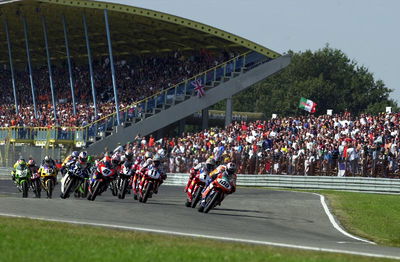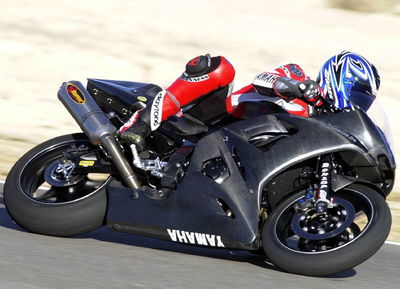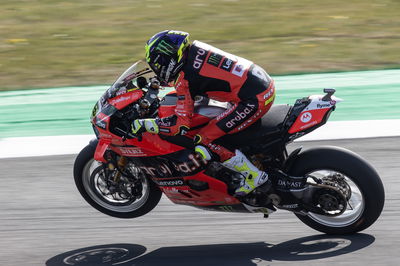Four-cylinder air restrictors announced.
The Superbike Commission, composed of Messrs. Claude Danis (FIM), Paolo Alberto Flammini (SBK International), Takanao Tsubouchi (MSMA) and Giulio Bardi (Team representative), has unanimously decided to introduce the following modifications to the World Superbike Championship for 2003.
The air restrictors will only be for 1000cc 4-cylinder machines in 2003, but look set to be adopted by all machines [to different degrees] the following year.
Next year, the 1000cc 'fours' will have a 32.5mm restrictor to allow the two-cylinder 'twins' to still compete.

The Superbike Commission, composed of Messrs. Claude Danis (FIM), Paolo Alberto Flammini (SBK International), Takanao Tsubouchi (MSMA) and Giulio Bardi (Team representative), has unanimously decided to introduce the following modifications to the World Superbike Championship for 2003.
The air restrictors will only be for 1000cc 4-cylinder machines in 2003, but look set to be adopted by all machines [to different degrees] the following year.
Next year, the 1000cc 'fours' will have a 32.5mm restrictor to allow the two-cylinder 'twins' to still compete.
Previously, only 750cc four cylinder machine were allowed to compete against the 1000cc 'twins' raced by the likes of Ducati, Aprilia and Honda. This made the machines entered by the factory Suzuki and Kawasaki teams uncompetitive, which many cite as a reason for their departure to MotoGP.
However, the new rules look set to spice up the competition, although any four cylinders this year will be privateer entries only. Honda look set to rejoin the series with a four-cylinder Fireblade in 2004.
The full official FIM ruling can be seen below...
Art. 2.4.4.1 Restrictors:
1) All the air feeding the engine must pass through the air restrictor(s).
2) If the air restrictor is NOT included in the throttle body as homologated by the FIM, the air restrictor must be located somewhere between the throttle valve at the throttle body and the cylinder head (not including the cylinder head itself).
The air restrictor must have a round aperture with a diameter no larger than 50 mm for 2-cylinder engines (as from 2004) and 32.5 mm for 4-cylinder engines and must be of non-deforming metal or metal alloy with a thickness of at least 3 mm [It is necessary to check its diameter on two (or more) directions].
3) If the air restrictor is included in the throttle body as homologated by the FIM, the shape of the restrictor may be oval, but the area of the aperture must be precisely the same as for a round restrictor, as mentioned above.
Note. This rule also applies to the Endurance World Championship.
A new FIM Homologation Procedure for Superbike, Supersport, Stocksport and Superproduction classes will also apply from 2004. Those interested in the new requirements to be met by Foggy Petronas, Ducati, Honda etc. can read the full FIM ruling on Homologation below...
FIM Homologation procedure for Superbike, Supersport, Superstock and Superproduction (from 1.1.2004):
Eligilibilty Requirements*All motorcycles must conform to the 1968 Vienna Convention
*The motorcycles are of current production.
*The motorcycles must represent machines of mass production.
*The motorcycles must be readily available to the public wanting to obtain high performance machines.
*The motorcycles are to be sold for every day use.
*The motorcycles must be completely equipped with all road going equipment. (I.e. full lighting equipment).
*All motorcycles must comply in every respect with all the requirements for road racing as specified in this
Appendix.
*All motorcycles must have a valid road homologation. (I.e. DOT, ECE 97 ECT.)
2.9.1 Requirements for an FIM homologationMotorcycles eligible for an FIM homologation must meet the following requirements:
*Only the original manufacturer may present the motorcycle for homologation.
*The manufacturer must be a holder of an FIM Manufacturer's licence.
*If the motorcycle is presented with an engine from a motorcycle manufacturer different from the manufacturer requesting the homologation, a permission or commercial agreement must be presented at time of the homologation request.
*The motorcycle must have a manufacturer's certificate of origin.
*The motorcycle must be legal and homologated for normal road use, without regards to its configuration.
*The motorcycle must be of current mass production and available to the public through the normal commercial channels of the manufacturer worldwide.
*N.B. If for marketing reasons or legal requirements, another type of carburation instruments is fitted to the model in a particular geographical area, these instruments must be replaced for competition using the homologated instrument.
2.9.2 Minimum production quantitiesThe annual production figures of the manufacturer who requests the homologation does not include the production quantities of 50 cc automatics and 50cc scooters, when establishing the minimum quantity of motorcycles required for a FIM homologation.
1) Supersport, Stocksport and SuperproductionProof of production quantities must be provided by certified documentation.
*All manufacturers must produce a minimum quantity of 1000 units before the date of homologation. A minimum quantity of 25 units must be shown at the time of homologation inspection.
2) SuperbikeProof of production quantities must be provided by certified documentation.
First Homologation
*For any manufacturer a minimum quantity of 150 motorcycles will be required to be built (75 units at the time of the homologation inspection and 75 units within a six month period following the homologation.
Second Homologation
*The manufacturers producing over 100,000 motorcycles per year must produce a minimum of 500 units. These motorcycles must be identical to the homologated model with same specifications and available worldwide. The minimum of 500 units must have been reached prior to the homologation inspection.
*The manufacturers producing over 50,000 motorcycles and less than 100,000 motorcycles per year must produce a minimum of 250 units. These motorcycles must be identical to the homologated model with same specifications and available worldwide. The minimum of 250 units must have been reached prior to the homologation inspection.
*The manufacturers producing less than 50,000 motorcycles must produce a minimum of 150 units. These motorcycles must be identical to the homologated model with same specifications and available worldwide. The minimum of 150 units must have been reached prior to the homologation inspection.
2.9.3 Dates for application, submissions & publications*The deadline for receiving requests for homologation at the FIM Executive Secretariat, is 45 days before the homologation inspection is to take place.
*A newly homologated motorcycle may race in the FIM Championship events, 45 days following the homologation inspection.
*After the homologation inspection, manufacturers are required to send the completed and signed Homologation forms 1, 2 and 3, together with all relating documentation, to the FIM Executive Secretariat. The deadline for receiving the completed, signed, and corrected homologation documents is 7 days following the homologation inspection.
*Within 7 days of the new homologation documents arriving at the FIM Executive Secretariat, the updated Homologation list will be published.
*At any time, copies of the homologation form 1,2 & 3 and photographs (DIN A4 size) may be requested from the FIM Executive Secretariat and are available on the FIM secured website.
2.9.4 Application, Inspection and Homologation*Only the original manufacture may submit to the FIM Executive Secretariat for the homologation of a motorcycle.
*The original manufacturer may apply for a new homologation, a maximum of 2 times per year, in each racing class.
*The inspection of the motorcycle presented for homologation will be carried out according to the information requested on the forms produced by the FIM (Homologation Form 1, 2 and 3).
*A technical member of the CCR, or the Technical Director of the World Superbike and Supersport Championships, will carry out the homologation inspection at the manufacturer's facilities.
*The inspector must satisfy himself that the claims made on the production certificate (Form 2) are correct.
*The inspector must select at random 2 motorcycles for detailed inspection. One of these two must be disassembled sufficiently for all relevant measures to be taken. Inspection and disassembling will take place immediately once the selection has taken place. The inspector will remain present throughout the examination.
*The manufacturer shall at all times be responsible to complete the homologation documents with the correct information. All dimensions must be given according to the metric system, excluding wheel dimensions.
*After the inspection, the manufacture will sign the completed certificates of homologation. These signed homologation forms indicate that the manufacturer will comply with the specifications mentioned on the homologation forms.
*Homologation documents with missing information will be returned to the manufacturer for correction. Corrected homologation documents must be returned immediately to the Executive Secretariat
*The homologation forms will be studied by the FIM Executive Secretariat to confirm that they are complete and correct prior to granting the homologation.
*Once a motorcycle has been homologated, it may be used for a maximum period of 5 years, or until such a time that the homologated motorcycle no longer complies with the technical rules.
*A manufacture can request an extension of a homologation before the end of the 5 year homologation period. The FIM may grant an extension of the homologation. The extension will be for 2 years. The homologation fee for an extension will be double the normal fee.
2.9.5 Product update*The following changes in the specifications of a FIM homologated motorcycle, will require a new homologation:
The moving parts of the engine
Crankcase
Cylinder head
The frames main dimensions [in relation to wheelbase, caster, steering head angle, relative location of the swing-arm, relative location of rear shock absorber(s)]
New engine prefix number
New frame prefix number
2.9.6 Homologation extension for product update*Product updates on other parts than frame and engine, such as the fairing, carburation instruments, wheels, etc can be granted by a homologation extension.
*In case of homologation extension because of product update, the manufacturer must send a notice to FIM. The deadline for receiving requests for homologation extension at the FIM Executive Secretariat, is 45 days before the first race of the new model that will be used in competition.
*After the formal notice, the manufacturer is required to send the Homologation forms 1, 2 and 3, together with all relating documentation about the product update (the drawings of the old and new products, etc) including a statement from which VIN-Number on the Product update is applicable, to the FIM Executive Secretariat.
*Only motorcycles, which have higher VIN number than the ones stated by the manufacturer are allowed to race using the new updated parts.
*The minimum production quantities valid for a homologation extension are the same quantities as for new motorcycle homologation.
*For an homologation extension for product update FIM will charge half of the homologation fee.
2.9.7 Carburation Instruments for Superbikes*The carburation instruments must be use unmodified either as the original homologated carburetion instrument or as the homologated optional carburation instrument.
*The only modifications allowed to the homologated carburation instruments original or optional are jets, needles, throttle valves and bell mouths.
*The original manufacturer must use the following criteria for the designing and making of the optional homologated carburation instruments.
a) There is no limit for the intake size of an engine equipped either by carburettors or fuel injection systems.
b) The optional carburettor / injector body material must remain the same as used on the original homologated carburation instruments.
c) A minimum number of optional carburation instruments must be available as spare parts and be included in the manufacturer's racing parts lists. All manufacturers must have a minimum of 15 sets available through traditional distributorships worldwide. The price to the public of the optional carburation instruments must not exceed twice the manufacturers suggested retail price of the original homologated carburation instrument in the country of origin. This price must be indicated on the Homologation Form.
d) The motorcycle manufacturer may submit only one optional carburation instrument for each model at the time of homologation.
e) The motorcycle manufacturer must supply a sample set of the original and optional carburation instruments to the FIM for use as comparison samples at the World Superbike events.
f) The motorcycle manufacturer must provide evidence that the minimum of 15 sets of optional carburation instruments have been manufactured.
g) The optional carburation instruments must be available for at least three years after the homologation date.
h) The Carburation instrument homologation will be valid for the same period as the homologated motorcycle.
i) An additional model of optional carburation instruments may be homologated during the life of the machine's homologation. These carburation instruments must meet the same requirements as the original modified instruments. This is to allow development after the original homologation.
*The optional carburation instruments may only be homologated at the same time as a new homologation. [see number I) above for additional optional carburation instruments]












